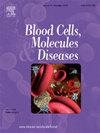A case series of cerebrovascular abnormalities in Townes sickle cell mice visualized with magnetic resonance imaging and angiography
IF 1.7
4区 医学
Q3 HEMATOLOGY
引用次数: 0
Abstract
Arterial complications in sickle cell disease (SCD), including stenoses and occlusions, are critical contributors to stroke. Townes SCD mice exhibit neurocognitive deficits and micro-vasculopathy, however stenoses and occlusions that could be causal to ischemic strokes have not yet been confirmed, which has led to challenges whether murine pathology reflects human pathology for strokes due to SCD. In our longitudinal study using label-free magnetic resonance angiography (MRA) to image carotid arteries in Townes SCD mice as they aged from 1 to 7 months, we identified multiple stenoses and occlusions consistent with abnormalities seen in individuals with SCD and stroke complications. We report three cases showing abnormalities: Case 1, middle cerebral artery occlusion associated with seizures and a T1-weighted hyperintense lesion in the brain; Case 2, persistent internal carotid artery occlusion and side-specific artery size differences; and Case 3, persistent stenosis in the common carotid artery with aging. This study highlights the utility of MRA in tracking arterial changes in SCD mice where assessing symptomatic damage due to stroke is challenging. This study provides evidence of mouse-to-mouse variability in initiation and persistence of stenoses and occlusions resembling the variability of SCD complications in humans.
Headline
MRA identifies arterial lesions in mice with SCD.
用磁共振成像和血管造影观察唐氏镰状细胞小鼠脑血管异常
镰状细胞病(SCD)的动脉并发症,包括狭窄和闭塞,是卒中的关键因素。Townes SCD小鼠表现出神经认知缺陷和微血管病变,然而,可能导致缺血性中风的狭窄和闭塞尚未得到证实,这导致了小鼠病理是否反映人类SCD所致中风病理的挑战。在我们的纵向研究中,使用无标签磁共振血管造影(MRA)对1至7个月大的Townes SCD小鼠的颈动脉进行成像,我们发现了与SCD和卒中并发症患者的异常一致的多发性狭窄和闭塞。我们报告了三例表现异常的病例:病例1,大脑中动脉闭塞与癫痫发作和大脑t1加权高信号病变相关;病例2,持续性颈内动脉闭塞与侧位特异性动脉大小差异;病例3,颈总动脉持续狭窄伴衰老。这项研究强调了MRA在追踪SCD小鼠动脉变化中的实用性,其中评估中风引起的症状性损伤是具有挑战性的。这项研究提供了小鼠与小鼠之间在狭窄和闭塞的发生和持续方面的可变性的证据,类似于人类SCD并发症的可变性。emra可识别SCD小鼠的动脉病变。
本文章由计算机程序翻译,如有差异,请以英文原文为准。
求助全文
约1分钟内获得全文
求助全文
来源期刊
CiteScore
4.90
自引率
0.00%
发文量
42
审稿时长
14 days
期刊介绍:
Blood Cells, Molecules & Diseases emphasizes not only blood cells, but also covers the molecular basis of hematologic disease and studies of the diseases themselves. This is an invaluable resource to all those interested in the study of hematology, cell biology, immunology, and human genetics.

 求助内容:
求助内容: 应助结果提醒方式:
应助结果提醒方式:


